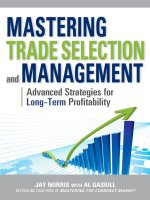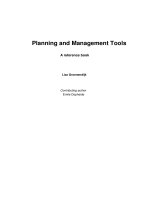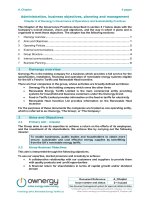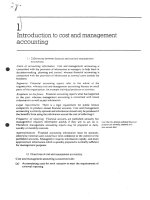Hedge fund compliance risks regulation and management
Bạn đang xem bản rút gọn của tài liệu. Xem và tải ngay bản đầy đủ của tài liệu tại đây (1.91 MB, 198 trang )
Hedge Fund
Compliance
Founded in 1807, John Wiley & Sons is the oldest independent publishing
company in the United States. With offices in North America, Europe, Australia, and Asia, Wiley is globally committed to developing and marketing
print and electronic products and services for our customers’ professional
and personal knowledge and understanding.
The Wiley Finance series contains books written specifically for finance
and investment professionals as well as sophisticated individual investors
and their financial advisors. Book topics range from portfolio management
to e-commerce, risk management, financial engineering, valuation and financial instrument analysis, as well as much more.
For a list of available titles, visit our Web site at www.WileyFinance.com.
Hedge Fund
Compliance
Risks, Regulation, and
Management
JASON SCHARFMAN
Copyright © 2017 by John Wiley & Sons, Inc. All rights reserved.
Published by John Wiley & Sons, Inc., Hoboken, New Jersey.
Published simultaneously in Canada.
No part of this publication may be reproduced, stored in a retrieval system, or transmitted in
any form or by any means, electronic, mechanical, photocopying, recording, scanning, or
otherwise, except as permitted under Section 107 or 108 of the 1976 United States Copyright
Act, without either the prior written permission of the Publisher, or authorization through
payment of the appropriate per-copy fee to the Copyright Clearance Center, Inc., 222
Rosewood Drive, Danvers, MA 01923, (978) 750-8400, fax (978) 646-8600, or on the Web
at www.copyright.com. Requests to the Publisher for permission should be addressed to the
Permissions Department, John Wiley & Sons, Inc., 111 River Street, Hoboken, NJ 07030,
(201) 748-6011, fax (201) 748-6008, or online at />Limit of Liability/Disclaimer of Warranty: While the publisher and author have used their best
efforts in preparing this book, they make no representations or warranties with respect to the
accuracy or completeness of the contents of this book and specifically disclaim any implied
warranties of merchantability or fitness for a particular purpose. No warranty may be created
or extended by sales representatives or written sales materials. The advice and strategies
contained herein may not be suitable for your situation. You should consult with a
professional where appropriate. Neither the publisher nor author shall be liable for any loss
of profit or any other commercial damages, including but not limited to special, incidental,
consequential, or other damages.
For general information on our other products and services or for technical support, please
contact our Customer Care Department within the United States at (800) 762-2974, outside
the United States at (317) 572-3993 or fax (317) 572-4002.
Wiley publishes in a variety of print and electronic formats and by print-on-demand. Some
material included with standard print versions of this book may not be included in e-books or
in print-on-demand. If this book refers to media such as a CD or DVD that is not included in
the version you purchased, you may download this material at .
For more information about Wiley products, visit www.wiley.com.
Library of Congress Cataloging-in-Publication Data is available
ISBN 978-1-119-24023-5 (Hardcover)
ISBN 978-1-119-24027-3 (ePDF)
ISBN 978-1-119-24026-6 (ePub)
Cover Design: Wiley
Cover Images: (top) © g0d4ather/Shutterstock; (bottom) © Rawpixel.com/Shutterstock
Printed in the United States of America
10 9 8 7 6 5 4 3 2 1
For R, Y, and Z
Contents
Preface
CHAPTER 1
Introduction to Hedge Fund Compliance
Introduction
Differences in Hedge Fund and Other Alternative Fund
Compliance
Hedge Fund Compliance Is Not Specific to One Country
Do Alternative Investments Merit Special Compliance
Considerations?
Understanding the Hedge Fund Compliance Framework
Introduction to the Hedge Fund Compliance Function
Distinguishing the Legal and Compliance Departments
Key Players in Compliance
Standard Areas Covered by a Hedge Fund Compliance
Function
Compliance Function Roles and Authority
Chapter Summary
Notes
CHAPTER 2
Introduction to Hedge Fund Regulation and Examination
Introduction
Different Types of Regulation for Different Financial Entities
Why Regulation Is Needed
Where Do Compliance Rules Come From?
National and Global Jurisdiction
Common Regulatory Interaction with Hedge Funds
Regulatory Examinations
Chapter Summary
Notes
xi
1
1
1
4
5
9
10
11
12
14
16
17
17
18
18
18
20
22
23
24
25
28
28
vii
viii
CONTENTS
CHAPTER 3
The Chief Compliance Officer and Regulatory Reporting
Introduction
Introducing the Chief Compliance Officer
Regulatory Reporting
Regulatory Reporting in Multiple Jurisdictions
Common Regulatory Reporting Questions
A Multistep Process
Chapter Summary
Notes
CHAPTER 4
In-House Compliance Professionals and Hedge Fund Committees
Introduction
Common Compliance Function Tasks
Firm Committees as Compliance Mechanisms
Chapter Summary
Note
CHAPTER 5
Hedge Fund Compliance Technology
Introduction
Understanding the Hedge Fund Information Technology
Function
Primary Compliance Uses of Technology
Compliance Considerations for Use of Electronic Data
Compliance Oversight of Nonelectronic Data
Business Continuity and Disaster Recovery Planning
Chapter Summary
Notes
CHAPTER 6
Compliance Consultants and Other Compliance-Related Service
Providers
Service Provider Compliance
Classification of Compliance Service Providers
Service Provider Compliance Work
Hedge Fund Compliance Consultants
Chapter Summary
Note
30
30
30
34
34
35
35
40
41
42
42
43
49
53
54
55
55
55
58
59
64
64
65
66
67
67
67
68
69
82
82
Contents
CHAPTER 7
Understanding Key Compliance Documentation
Reasons for Documenting Compliance Policies and
Procedures
Understanding the Goals of Compliance Documentation
Jurisdictional Differences in Compliance Documentation
Understanding Boilerplate Documentation
Core Compliance Documentation
Chapter Summary
Note
CHAPTER 8
Investor Evaluation of Hedge Fund Compliance Functions
Introduction
Compliance Evaluations in Investor Due Diligence
Initial and Ongoing Compliance Analysis
Evaluating Best Practice Compliance
Key Compliance Analysis Areas
Chapter Summary
Note
CHAPTER 9
Case Studies and Example Scenarios in Hedge Fund Compliance
Introduction
Compliance Scenario 1
Compliance Scenario 2
Case Studies
Chapter Summary
Notes
CHAPTER 10
Common Compliance Pitfalls and How to Avoid Them
Introduction
Pitfall 1: Small Firms Build Large Firm Compliance
Infrastructures
Pitfall 2: Underspending on Compliance
Pitfall 3: Lack of Independent Compliance Reporting
Pitfall 4: Outsourcing All Compliance
Pitfall 5: Relying on Technology and Compliance
Automation
ix
83
83
84
85
85
88
97
98
99
99
99
101
104
109
118
118
119
119
119
122
123
129
129
131
131
131
133
134
135
136
x
CONTENTS
Pitfall 6: Letting Investor Opinion Drive Compliance
Priorities
Chapter Summary
Notes
CHAPTER 11
Interviews with Compliance Service Providers
Introduction
Interview with Kent Wegrzyn (ACA Compliance Group)
Interview with Vinod Paul (Eze Castle Integration)
Chapter Summary
CHAPTER 12
Trends and Future Developments
Introduction
Chief Compliance Officers Personal Liability Concerns
Increased Senior Manager Regulatory Accountability
Compliance-Related Insurance
Increasingly Coordinated Hedge Fund Regulation in Europe
Chapter Summary
Notes
137
138
139
140
140
140
160
171
172
172
172
174
175
176
177
178
About the Author
181
About the Companion Website
183
Index
185
Preface
ompliance is one of the fastest-growing areas in the hedge fund industry.
Contributing to this change is a seemingly steady drumbeat of new global
regulatory activity. In the United States and in Asia, for example, regulators have steadily enhanced their hedge fund compliance enforcement and
surveillance activities. In Europe, broad shifts in the laws, such as the Alternative Investment Fund Managers Directive (AIFMD) and the Markets in
Financial Instruments Directive (MiFID), have directly influenced the way
hedge funds carry out their investment activities.
Today, hedge fund compliance has evolved into more than simply a
regulatory exercise. Hedge fund compliance programs are now required to
regularly engage compliance risks across a wide variety of operational and
investment areas, ranging from cybersecurity and conflict of interest management to trade allocation and increased oversight of the use of investment
research. To meet these challenges, hedge funds and their investors and service providers must continually reevaluate the role of the compliance function to ensure that they not only meet these new regulatory requirements
but also keep pace with industry best practices. This book is written to assist
these groups in embracing this challenge.
Readers of this book will come from different levels of sophistication,
ranging from those in an academic setting and new to hedge fund industry
to experienced hedge fund compliance professionals working in the compliance field. To assist in highlighting important compliance terminology as you
read through each of the chapters, you will find key terms italicized and in
boldface. Regardless of your previous compliance experience, this book can
also serve as a reference source on specific compliance topics. To facilitate
this, the chapters of this book have been organized by key compliance topic
area for ease of navigation.
Specifically, this book is structured to provide an understanding of the
core concepts of hedge fund compliance across three sections. The first
section, Chapters 1 through 4, focuses on topics relating to the structure and
duties of a hedge fund’s internal compliance function. It begins by providing
an introduction to the compliance function and the role of regulators. The
Chief Compliance Officer (CCO) role, as well as the responsibilities of
other shared and dedicated compliance personnel, are then discussed. This
C
xi
xii
PREFACE
section concludes with an analysis of the function of internal compliance
mechanisms, such as fund committees.
The second section of the book, Chapters 5 through 8, focuses on specific topics in compliance as well as the role of third parties in the process.
This section begins by addressing the emerging role of technology in compliance management. The use of technology in performing a wide variety of
compliance activities, including trade surveillance, archiving, and monitoring employee communications, is also covered. Next, the role of third parties
that assist in compliance management, including compliance consultants, is
discussed. Examples of key compliance documentation, including the Compliance Manual and Code of Ethics, are then presented. Finally, the process
by which prospective and existing investors conduct due diligence on hedge
fund compliance functions is addressed with a focus on the analysis of compliance policies regarding employee personal account dealing and material
non-public information (MNPI).
The third and final section of the book, Chapters 9 through 12, applies
critical compliance concepts directly to the real world. It begins by focusing on historical case studies and illustrative scenarios as well as common
compliance pitfalls. Interviews with third-party compliance service providers
are presented to demonstrate the practical opportunities and challenges facing hedge funds in working with third parties to implement and manage
their compliance programs. Finally, the book concludes with a discussion of
emerging topics and trends in the compliance space.
Compliance has evolved from a rote exercise of strictly following regulatory rules to one of the most prominent, dynamic, and multidisciplinary
areas of hedge fund management. A strong compliance program can improve
the overall operating efficiency and level of communication throughout a
hedge fund. Similarly, hedge fund investors benefit from the additional oversight and transparency that comprehensive compliance programs can provide. Regardless of your role in the hedge fund industry, as compliance
continues to evolve, developing a fundamental understanding of core compliance concepts is now an essential requirement for success.
Jason Scharfman
December 2016
CHAPTER
1
Introduction to Hedge Fund
Compliance
INTRODUCTION
Nearly every profession, whether it is asset management, healthcare,
construction, or scientific research, has some areas that require rules and
regulations to be followed. At its most basic level, the term compliance
refers to the processes and procedures by which an organization adheres
to these guidelines. These guidelines may come from a variety of sources.
Traditionally, the government is the primary initiator of compliance rules
for different industries, but they may come from other sources as well.
Compliance has become a critically important component of investment management and this is particularly true in the hedge fund space.
Key questions this book will seek to answer include:
■
■
■
■
■
■
■
What exactly is hedge fund compliance?
How can hedge funds design and improve their compliance function?
What constitutes best practice compliance?
What role do financial regulators play in implementing and monitoring
compliance?
Why should investors care about hedge fund compliance?
What role can third-party service providers play in compliance?
What global compliance trends are emerging in the hedge fund industry?
DIFFERENCES IN HEDGE FUND AND OTHER ALTERNATIVE
FUND COMPLIANCE
Within the sphere of alternative investment fund managers, the lack of
homogeneity creates a number of unique compliance challenges. Indeed,
separate books could be written about the different compliance frameworks
Hedge Fund Compliance: Risks, Regulation, and Management, Jason Scharfman
© 2017 by by John Wiley & Sons, Inc. All rights reserved. Published by John Wiley &
Sons, Inc.
1
2
HEDGE FUND COMPLIANCE
required to address the intricacies of different alternative asset classes, such
as real estate and private equity.
Hedge funds, too, are unique from a compliance perspective. In particular, they tend to be one of the more complex fund management entities.
Why? For starters, let us clarify what the term hedge fund refers to. Hedge
fund is a broad umbrella term used to classify many different types of managers that may be organized under differing fund legal structures. The broad
nature of the term is one of the reasons that make the category of fund
managers known as hedge funds unique and challenging from a compliance
perspective. Other key reasons for the increased complexity of hedge fund
compliance include:
■
■
■
Variety of different strategies employed—Hedge funds utilize a number
of different investing strategies. Common hedge fund trading strategies
include global macro; long-short equity; market neutral; event-driven
strategies, including merger arbitrage and special situations; convertible
arbitrage; sector funds, including healthcare or energy funds; quantitative strategies; and even multistrategy funds. Although other types
of alternative investment categories contain distinctions, the variety
of investment strategies employed by hedge funds is relatively large in
comparison.
Trading and operating on a global scale—In many cases, hedge
funds may conduct not only trading but also fund-structuring and
asset-raising activities in multiple jurisdictions around the globe. This
global landscape contributes to the complexity of the compliance
environment surrounding hedge funds.
Wide range of instrument types traded—To facilitate both the trading activities of a wide number of strategies, as well as the broad
investment flexibility within different strategies, hedge funds often
trade a wide variety of instruments. These can include equities; swaps;
swaptions; forwards; futures; options; various types of bonds, including treasuries, convertible bonds, and catastrophe bonds; bankruptcy
claims; syndicated loans, including bank debt, mortgage-backed securities, private investments in public equity (PIPES), repos, and reverse
repos; commercial mortgage-backed securities (CMBS); and credit
default swaps (CDS). The use of different strategies can-not only
subject hedge funds to the oversight of different financial regulators and
exchanges but the combined effect of utilizing multiple instruments also
increases the complexity of administering compliance across various
security types.
Introduction to Hedge Fund Compliance
■
■
3
Variety of trading implementation strategies—To implement trading
strategies, hedge funds may employ a wide variety of trading procedures.
These may include variations on:
i. Who is actually deciding to trade? (i.e., a human being, an automated computer trader, or some combination of the two)
ii. The timing of trades—Are they spaced into the market over time or
all at once?
iii. The process of executing trades—Hedge funds may provide instructions to counterparties to execute trades in a number of different
ways, including over the telephone or through electronic methods,
such as instant message or e-mail. The reasons for this may depend
on a number of factors, including the size of the hedge fund, the
sophistication of a hedge fund’s trading platform, the markets they
trade in, and the way they work with trading counterparties. This
variety presents a number of unique compliance challenges.
Use of multiple prime brokers and other counterparties—Prime brokers are companies that facilitate the implementation of a hedge fund’s
trading strategy. Companies that provide prime brokerage services are
typically referred to as broker-dealers. In their work with hedge funds,
they typically offer hedge funds a number of services, including trade
clearing, execution, and leverage financing. Today, it is common for
hedge funds to utilize multiple prime brokers.
Hedge funds do this for a variety of reasons, including diversifying
their exposure across multiple counterparties as opposed to putting all
of their eggs in one basket. The risk in using a single prime broker was
highlighted after the 2008 failure of Lehman Brothers. There may also
be other types of brokers utilized in addition to prime brokers. One
example is brokers known as executing brokers. These brokers typically
work directly with prime brokers or, in some instances, directly with the
funds, in executing trades. Another type of broker is called a futures
commission merchant that facilitates trading in futures.
Hedge funds may also utilize a number of other trading counterparties for securities, such as swaps. These swap counterparties are commonly referred to in the industry as ISDA counterparties. This name
comes from the standard master agreement often used to implement
these arrangements that is provided by the the International Swaps and
Derivatives Association (ISDA).
The use of these multiple prime brokers and counterparties often
creates unique needs among hedge funds for specific compliance
oversight of the ways in which they interact with these groups.
4
HEDGE FUND COMPLIANCE
■
Enhanced research techniques—From an investment research perspective, hedge funds traditionally employ a relatively wide array of
techniques as compared to other fund managers. These avenues may
include research activities, such as discussion with industry experts,
and the utilization of expert networks. Expert networks are for-profit
companies that organize databases of individuals with expertise in
particular subjects or with particular companies. Expert networks then
coordinate conversations between fund managers and these individuals
in order to facilitate the fund manager’s research. Accompanying the use
of these research avenues are a series of additional layers of compliance
oversight that would not otherwise be present in other alternative
managers that do not engage in such techniques.
Each item listed above presents a specific set of compliance challenges
that we will address in more detail throughout this book. The important
takeaway at this stage is that, while there are certain core principles of compliance that can be applied across all asset classes, and within alternative
investments in particular, based on the broad trading activities, strategies,
and global scope of hedge funds, they present distinct compliance challenges
that merit specialized compliance considerations.
HEDGE FUND COMPLIANCE IS NOT SPECIFIC
TO ONE COUNTRY
Compliance is a heavily rules-based exercise. These rules are driven by the
laws and regulations of the different countries in which hedge funds operate.
Although we will address certain key aspects of different hedge fund regulations in the major countries in which hedge funds operate, this book is
meant to provide practical compliance advice on a global basis rather than
focus too heavily on the laws of any specific country. There are many other
more technical resources that can provide in-depth specific guidance on the
applicable compliance laws in any particular country.
Regional Compliance Expertise Used by Hedge Funds
In practice, many hedge funds engage in business activities in multiple countries. It is not practical for these hedge funds to maintain internal compliance
experts who have expertise in all of the countries in which they may operate.
To solve this problem, a hedge fund’s interpretation and implementation of
compliance guidelines in different countries often comes about as a result
of consultation with a number of different country-specific specialists.
To clarify some terminology, individuals or firms that are not employees of the hedge fund but provide services to it are commonly referred to as
Introduction to Hedge Fund Compliance
5
third parties, third-party firms, or service providers. Although not every service provider provides compliance-related services to a hedge fund, many do
in one form or another. One of the most common compliance-focused service
providers is known as a compliance consultant. Another type of hedge fund
service provider heavily involved in compliance is a law firm, which is also
sometimes referred to as a hedge fund’s legal counsel. The country-specific
compliance specialists that hedge funds heavily rely on in the compliance
area are typically either compliance consultants or legal counsel.
Another reason that many hedge funds utilize third-party compliance
consultants when operating in different countries is because compliance is an
evolving subject. As the laws and rules in different countries change, external
expertise can often provide valuable insight into trends in compliance practices in specific countries.
Benefits to Developing a Global Understanding
of Compliance
When studying the area of hedge fund compliance, there are benefits toward
first establishing a general understanding of the subject on a global basis
before delving too deeply into the rules of any one country. From the perspective of hedge fund employees, while individuals who are experts in the
compliance practices of any single country are, of course, valuable, developing a global understanding of general compliance policies coupled with
third-party country or region-specific compliance expertise as needed often
produces a much more holistic compliance program.
From the perspective of hedge fund investors seeking to evaluate hedge
fund compliance protocols, first developing a more general understanding
of core hedge fund compliance principles prior to any country-specific
knowledge is also advisable. This is because investors may allocate capital
to hedge funds in multiple jurisdictions, which are subject to different
compliance regimes. By developing this general compliance foundation first,
which is then complemented by country-specific compliance knowledge, a
more universal compliance due diligence program for investors will result.
Keeping both the hedge fund employee and the hedge fund investor
perspectives in mind should assist you as you work through the material.
DO ALTERNATIVE INVESTMENTS MERIT SPECIAL
COMPLIANCE CONSIDERATIONS?
Hedge funds are commonly grouped into an asset class known as alternative investments. Alternative investments differ from other types of investments, such as long-only mutual funds, commonly referred to as traditional
investments. For reference, a long-only fund is one that only engages in the
6
HEDGE FUND COMPLIANCE
purchasing and selling of investments, such as buying or selling equities.
These are long-only investments because the fund’s general strategy is to
make long-term predictions that the value of the investments will increase
over time. Long-only funds do not follow a strategy of selecting investments
by betting that the value of certain investments will decrease over time.
By contrast, an approach that seeks to profit from the decline in value
of a potential investment, such as betting for a decline in the price of the
shares of a publicly traded company, is known as short selling. Short selling
is typically carried out through the use of equity options. One hedge fund
strategy that combined both long- and short-selling techniques is known as
a long-short strategy. In addition, other hedge fund strategies may also typically involve the use of options and other short-selling techniques. Other
common types of alternative investments, often grouped alongside hedge
funds in this category, are private equity, real estate, and commodity funds.
Within the area of fund manager compliance, the question may be raised
whether alternative investment managers merit special compliance considerations as compared to traditional investment managers. When we refer to a
fund manager, unless otherwise stated, we are not referring to a specific individual, such as a portfolio manager, but rather to the management company
organization for which an individual known as a fund manager or portfolio manager typically works. Prior to answering the question of whether
a special classification category is required for hedge funds, we must first
understand the notion of market and regulatory classifications.
Contrasting Regulatory and Market Classifications
Most regulators have big categories by which they categorize similar types of
financial entities. This is in contrast to the smaller distinctions among different types of asset managers that may be made in the real-world marketplace.
When it comes to hedge funds, the majority of global financial regulations
do not maintain a separate classification for entities that may be classified
as a hedge fund, private equity fund, or any other alternative investment
vehicle. Instead, within the broad umbrella of regulatory fund manager entities, financial regulations are primarily more driven by the activities of these
fund managers. This concept highlights the distinction between what may
be referred to as a regulatory classification and a market classification of a
fund manager.
Understanding Regulatory Classifications A regulatory classification is the
way a fund manager would be classified based on predetermined regulatory
classification requirements. One way to think about regulatory classifications is the way in which a fund manager is viewed from a legal perspective.
Introduction to Hedge Fund Compliance
7
For example, in the United States, if a fund manager under the
Investment Advisers Act of 1940 (Advisers Act, or Act) and accompanying
statutes meets certain specific criteria, then the manager is classified as an
entity known as an Investment Adviser. In general, Section 202(a)(11) of the
Advisers Act defines an “Investment Adviser” as any person or firm that:
(1) for compensation; (2) is engaged in the business of; (3) providing
advice, making recommendations, issuing reports, or furnishing
analyses on securities.1
As you can see by these general criteria, the requirements are quite
broad. This means that whether an organization is a long-only mutual fund
or a long-short hedge fund manager, from a regulatory perspective, they are
both Investment Advisers.
If an organization does not meet each criterion and isn’t exempt for some
other reason, then the manager is generally not classified as an Investment
Adviser. Why does this classification matter? If a fund manager is not an
Investment Adviser, then it would generally not have to register with the U.S.
Securities and Exchange Commission (SEC). More specifically, the compliance programs of a registered hedge fund may be distinctively different from
an unregistered fund.
Understanding Market Classifications A market classification is the way a
fund chooses to portray itself in the market. Alternatively, it can be the way a
fund is classified, typically by investors, based on its actual trading activities.
Obviously, it is not in a hedge fund manager’s interest to misclassify their
activities, but sometimes these two classifications are the same, and in some
cases, there may be differences in classification methods, depending on the
classification requirements in place.
Market classifications can be contrasted from regulation classification
in two primary ways. First, under market classifications, there are no
bright-line criteria determining what constitutes one classification type (i.e.,
a global macro hedge fund) from another (i.e., an event-driven hedge fund).
For reference, a global macro hedge fund is a fund that follows a strategy
of investing in macroeconomic themes, typically utilizing a wide variety of
financial instruments on a global basis. An event-driven hedge fund follows
a strategy of investing around the occurrence of certain events, such as
corporate mergers or litigation.
Second, there are not necessarily any specific requirements, legal
or otherwise, imposed on a manager for labeling themselves, or being
labeled, under a market classification. This is in stark contrast to regulatory
classification, which can have a material impact on the activities of a
fund manager.
8
HEDGE FUND COMPLIANCE
Example of Market and Regulatory Classification Differences. To make
the distinction between regulatory and market classifications more concrete,
let us consider an example. Consider a U.S.-based fund manager that chooses
to promote itself to potential investors as a hedge fund. This would be the
market classification from the hedge fund’s perspective. A potential investor
may take a look at the fund manager’s actual, or planned, investment activities and instead classify the fund under a more detailed classification of a
global macro hedge fund. This would be an example of how the market classifications can differ, or at least be more specific, between the fund itself and
the investor.
As noted earlier, there is no specific regulatory classification for hedge
funds, so the fund cannot have the same market and regulatory classification
in this case. What would the regulatory classification be? If we focus on just
U.S. regulatory classifications, and not any other jurisdictions, and it is a
U.S.-based hedge fund that meets the SEC requirements outlined earlier, then
its regulatory classification would be that of an Investment Adviser. As this
example demonstrates, a hedge fund, therefore, can be correctly referred
to as being in different market or regulatory categories, depending on the
specific classification system in place.
When discussing hedge fund compliance, the regulatory classification is
typically the driving force over market classifications, as regulatory classifications facilitate the heart of the compliance guidelines that a hedge fund
must adhere to. However, it is important to understand the concept of market classification so that the appropriate distinctions can be made between
the two classification systems.
Example of multiple regulatory classifications. In the previous example,
we alluded to the fact that a hedge fund may have multiple regulatory
classifications. One reason for this multiple regulatory classification system
is because a hedge fund may be subject to multiple regulatory agencies.
To be clear, these classifications may come within the same country or
across multiple countries.
In some cases, this oversight is driven by a hedge fund’s trading activities. For example, certain hedge funds may engage in the trading of a type of
security known as commodity futures. A commodity future is a security that
allows a hedge fund to speculate on the future price of commodities, such
as lean hogs, coffee, cocoa, and copper. In the United States, if a hedge fund
were to engage in futures transactions, they would be regulated by the joint
efforts of two different regulators known as the National Futures Association (NFA) and Commodity Futures Trading Commission (CFTC). The NFA
is a type of agency known as a self-regulatory organization (SRO), whereas
the CFTC is a federal regulatory agency. SROs will be covered in more detail
in Chapter 2.
9
Introduction to Hedge Fund Compliance
As part of this oversight by the CFTC and the NFA, a hedge fund may
have to register under special regulatory classifications similar to the SEC’s
Investment Adviser category. Common classifications under the CFTC and
NFA regimes are for a fund manager to register as a Commodity Trading
Advisor (CTA), a Commodity Pool Operator (CPO), or perhaps as both.
UNDERSTANDING THE HEDGE FUND COMPLIANCE
FRAMEWORK
With an understanding of why hedge funds present unique compliance challenges, we can begin to introduce more specifics related to the way compliance is approached in hedge funds. To do this, we will first analyze the
makeup of a hedge fund’s compliance framework. This will be followed by
an introduction of the hedge fund compliance function. Last, the key parties
in a hedge fund’s compliance framework will be discussed.
A hedge fund’s compliance framework is not just the compliance function within the hedge fund itself. This is a common point of confusion among
investors in particular. While certainly, the heavy lifting is performed by the
compliance function, there are also other elements within the hedge fund that
perform compliance-related functions. Furthermore, outside of the hedge
fund, there are a number of service providers and counterparties that also
perform compliance-related functions. This relationship is summarized in
Exhibit 1.1.
Internal hedge fund
compliance function
Compliance focused services
providers
Other services providers (that
also provide compliance-related
services)
EXHIBIT 1.1 Components of a Common Hedge Fund Compliance Framework
10
HEDGE FUND COMPLIANCE
Therefore, to fully understand the entire hedge fund compliance playing
field, we must look beyond the compliance function within the hedge fund
to analyze all of the key compliance stakeholders, both inside and outside
the fund.
INTRODUCTION TO THE HEDGE FUND COMPLIANCE
FUNCTION
The hedge fund compliance function, or compliance department, refers to a
group within the hedge fund whose responsibility is to develop, implement,
maintain, and test compliance policies and procedures. The compliance function often sits alongside other operational groups, such as fund accounting
or technology.
One structure for a hedge fund compliance department is a dedicated
compliance function. Under this structure, the compliance function only
focuses on compliance-related tasks. This is in contrast to a shared compliance function structure, in which the compliance function may be combined
with other departments within the hedge funds. A common structure for a
hedge fund with a dedicated compliance function is outlined in Exhibit 1.2.
In a perfect world, every hedge fund would have enough resources
to devote to developing a stand-alone dedicated compliance function (see
Exhibit 1.2). In practice, for a number of reasons, including resource
constraints, this is not always the case.
Employees who work in the compliance function may be shared among
different groups and have multiple responsibilities. We will address the
pros and cons regarding these different compliance structures in subsequent
chapters. For now, the important thing to remember is regardless of whether
Chief Investment
Officer
Chief Operating
Officer
Human
Resources
Accounting
Compliance
Investment
Research
Legal
Information
Technology
EXHIBIT 1.2 Example Organizational Structure of a Hedge Fund with a Dedicated
Compliance Function
Introduction to Hedge Fund Compliance
11
compliance department employees are shared, there will be individuals
within the hedge fund who have a duty, in one form or another, to oversee
compliance.
DISTINGUISHING THE LEGAL AND COMPLIANCE
DEPARTMENTS
As Exhibit 1.2 demonstrates, a hedge fund may maintain both a legal and
a compliance department. While these two departments may overlap with
each other, they generally have different goals.
In other cases, a hedge fund may combine the legal and compliance
functions into a single department. Reasons for this can include resource
constraints on the hedge fund and a desire to centralize the responsibilities
of certain individuals within the hedge fund. The two functions overlap to
some extent, and combining them can represent a practical use of hedge fund
personnel in certain instances.
The Legal Department Function
As can be expected, the legal function of a hedge fund is traditionally focused
around tasks surrounding more legal, as opposed to compliance, matters.
These legal tasks can cover a wide area. Common legal tasks performed by
hedge funds typically include:
■
■
Traditional contract work—Similar to many other businesses and fund
managers, hedge funds engage in legal contracts, including employment
contracts with senior personnel, rental agreements for office space, and
vendor and service provider contracts. The legal tasks related to these
contracts include drafting, reviewing, and negotiating contracts a hedge
fund may enter into with a variety of parties.
Litigation management—Hedge funds may sometimes be involved in
lawsuits. These lawsuits may be initiated for a wide variety of reasons,
including
a. Portfolio-related litigation—Sometimes a hedge fund will initiate, or
participate, in legal proceedings as part of the its investment strategy.
b. Employment related litigation—Disputes may arise between a hedge
fund and its employees, which includes direct employees of the fund
as well as any consultants or other classes or individuals to which
a hedge fund may maintain an employment obligation. These types
of lawsuits can be broken up into two primary categories. The first
category would be suits brought by the fund manager. The second
would be those brought by employees.
12
■
HEDGE FUND COMPLIANCE
Third-party law-firm management—Hedge funds often work with thirdparty law firms to assist in a variety of legal matters, including those
referenced earlier. A common internal legal task at a hedge fund is
managing the work of these third-party firms.
Related but Not Equivalent
The legal and compliance functions of a hedge fund are often thought of as
being related departments because a number of similarities exist between the
two groups. There are several reasons for this, including
■
■
■
Traditional shared coverage of both functions—The head of the legal
function is commonly given the title of General Counsel, while the compliance function head is commonly referred to as the Chief Compliance
Officer. Although not every hedge fund maintains a general counsel,
historically the General Counsel at a hedge fund would have also maintained responsibilities for compliance-related functions. For example,
it might not be uncommon for an individual with the title of General
Counsel to also hold the title of Chief Compliance Officer.
Shared basis in the law—Compliance and legal functions are both rooted
in the law and legal principles; hence, the overlap among the functions.
Complementary functions—The compliance and legal functions may be
subject to oversight by each other in certain areas. For example, the
activities of a hedge fund’s legal department employees are typically subject to compliance oversight. Similarly, the development of compliance
materials may require input from those with specialized legal expertise,
which may come from the legal department.
So, while the hedge fund’s legal and compliance functions overlap to a
certain degree, the specific duties and goals are different—they are related
but not equivalent.
KEY PLAYERS IN COMPLIANCE
A hedge fund’s compliance efforts may be primarily driven by internal personnel. When this is the case, there are various individuals and groups that
may be involved in the compliance function including those outlined below:
■
Chief Compliance Officer (CCO)—The most prominent compliance
professional is the Chief Compliance Officer. In addition to leading
the compliance function, the CCO fulfills regulatory requirements.
Introduction to Hedge Fund Compliance
■
■
■
■
■
13
Specifically, many regulators around the world require hedge funds to
designate a CCO.
In addition, the CCO typically assists a hedge fund in complying
with a number of other regulatory duties, including filing regulatory
reports, developing compliance policies and managing daily compliance audit calendars. The CCO position is discussed in more detail in
Chapter 3.
Additional compliance personnel—Similar to the CCO role, other
compliance individuals may or may not be dedicated to compliance
functions. Although the CCO position is mandated by regulators, other
positions are not, and a fund may not have any other additional compliance employees. If this is the case, the CCO may perform all essential
compliance functions themselves, or those tasks are outsourced, such
as to a compliance consultant.
Shared compliance employee—A shared compliance employee is an
individual who performs certain compliance duties in addition to other
responsibilities outside of the compliance function.
Consider an example of a compliance department that is made up
of six people, five of whom work solely on compliance-related tasks.
The sixth person spends part of their time on compliance duties and the
rest on noncompliance tasks, such as fund accounting. Under this structure, the compliance department may be referred to as either dedicated
with supporting resources or a mixed compliance department.
Noncompliance personnel—Noncompliance personnel perform jobs in
which compliance matters are not part of their daily activities. These
individuals include everyone from investment professionals to fund
accounting personnel. This does not mean they ignore the compliance
function, but they do not focus on it as part of their regular duties.
Compliance consultants—Compliance consultants are third-party firms
that provide advice on compliance-related matters to hedge funds. Their
services range from completely running a hedge fund’s compliance
function to compliance policy development and assisting hedge funds
with ongoing compliance management. It is not a requirement for
hedge funds to maintain a compliance consultant, and not every hedge
fund will have one. The roles of compliance consultants are discussed
in more detail in Chapter 6.
Other compliance-related service providers—Other third-party service
providers can focus more on supporting the infrastructure of the hedge
fund, such as information technology consultants and utility companies.
Although third-party service providers are not focused exclusively on
compliance, they do perform compliance-related services. These other
service providers are also discussed in more detail in Chapter 6.
14
HEDGE FUND COMPLIANCE
STANDARD AREAS COVERED BY A HEDGE FUND
COMPLIANCE FUNCTION
At this point in the reading, several basic compliance concepts have been
introduced, and the structure of compliance departments has been discussed.
We can now turn our attention to the key areas covered by compliance.
Standard Areas Covered by a Hedge Fund
Compliance Function
At a very basic level, hedge fund compliance can be divided into two coverage areas: investment-related and non-investment-related compliance areas.
■
Investment-related compliance areas. These areas directly relate to
the investment management business of the hedge fund organization.
Traditionally, this is where the majority of hedge fund compliance
efforts are centered.
Take, for example, trade allocation, in which a hedge fund manages two different funds that adhere to primarily the same investment
strategy. Each fund has been created to accommodate the tax needs of
different types of clients (onshore and offshore). When funds are managed in this structure they are said to be managed in what is known
as a pari passu manner.2 One fund is structured for clients who are
typically based in the same country as the headquarters of the hedge
fund. This is known as the onshore fund. The other fund is for investors
based outside of the primary country in which the hedge fund operates.
This is known as the offshore fund. Funds organized in this manner typically are structured to sit beneath what is known as a master fund that
coordinates the underlying funds trading activities. In this structure, the
onshore and offshore fund would be referred to as feeder funds, and
the entire fund complex would be a master-feeder structure. Assume
that our master fund makes a single purchase of 100 shares of Google
stock. Typically, the stock would not remain at the master fund and
would need to be allocated between the onshore and offshore feeder
funds. But how should this allocation be completed? You might think
it would be easiest to split the shares 50–50 among the two funds.
Perhaps, however, the onshore fund contributed more of the capital to
make the purchase happen and trade should be allocated in a method
known as pro-rata trade allocation, which means that the trades should
be allocated proportionally. Or what if the fund manager intended to
buy more shares, or perhaps even all of the shares just for the onshore
fund alone?









